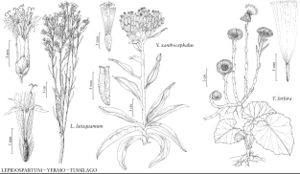Lepidospartum
Proc. Amer. Acad. Arts 19: 50. 1883.
| Taxon | Illustrator ⠉ | |
|---|---|---|
 | Lepidospartum latisquamum Yermo xanthocephalus Tussilago farfara | Linny Heagy Yevonn Wilson-Ramsey Yevonn Wilson-Ramsey |
Shrubs (treelets), 20–250 cm (juvenile stems and foliage tomentose, later stems and leaves glabrous or pannose to tomentose, sometimes glabrescent). Stems 1–5+, erect (much branched). Leaves cauline; alternate; petiolate or sessile; blades palmately (sometimes obscurely) nerved; the juvenile obovate to spatulate, on flowering-stems filiform to acerose or scalelike, margins entire, faces glabrous or tomentose to glabrescent. Heads discoid, in ± paniculiform arrays (or clusters of 3–5). Calyculi 0 (or bractlets intergrading with phyllaries). Involucres obconic to cylindric, 4–8 mm diam. Phyllaries persistent, 8–13 or 12–23+ in 2–4+ series, erect, distinct, mostly ovate to lanceolate, unequal (outer shorter), margins sometimes scarious. Receptacles flat, smooth or foveolate (glabrous or arachnose), epaleate. Ray-florets 0. Disc-florets 3–17+, bisexual, fertile; corollas pale to bright-yellow, tubes longer than campanulate to funnelform throats, lobes 5, recurved, lance-linear; style-branches: stigmatic areas ± continuous, apices rounded-truncate. Cypselae ± fusiform, 5–15-nerved, glabrous or ± pilose; pappi persistent, of ca. 150, white or tawny, barbellulate bristles (in 3–4 series). x = 30.
Distribution
sw United States, nw Mexico
Discussion
Species 3 (3 in the flora).
Selected References
None.
Key
| 1 | Leaf blades (flowering stems) scale-like, 2–3 mm; florets 9–17; cypselae glabrous | Lepidospartum squamatum |
| 1 | Leaf blades (flowering stems) filiform to acerose, 3–40 mm; florets 3–6; cypselae densely hairy | > 2 |
| 2 | Flowering stems tomentose with glabrous striae subtending leaves, interruptingtomentum; cypselae 5–6.5 mm | Lepidospartum latisquamum |
| 2 | Flowering stems evenly pannose, not striate, dotted with glandular blisters; cypselae ca. 4 mm | Lepidospartum burgessii |